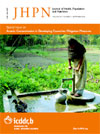
|
The Journal of Health, Population and Nutrition
icddr,b
ISSN: 1606-0997
EISSN: 1606-0997
Vol. 37, No. 1, 2018, pp. 1-7
|
 Bioline Code: hn18005
Bioline Code: hn18005
Full paper language: English
Document type: Research Article
Document available free of charge
|
|
|
The Journal of Health, Population and Nutrition, Vol. 37, No. 1, 2018, pp. 1-7
| en |
Age-sex disparities and sub-clinical hypothyroidism among patients in Tikur Anbesa Specialized Hospital, Addis Ababa, Ethiopia
Tekle, Habtamu Azene; Bobe, Tesfahun Molla; Tufa, Efrata Girma & Solomon, Fithamlak Bisetegen
Abstract
Background: Subclinical hypothyroidism is an elevation in serum thyroid-stimulating hormone above the upper
limit of the reference range (0.45–4.5 mIU/L) with normal serum TT4 and TT3 concentration. The most important
implication of subclinical hypothyroidism is high likelihood of progression of clinical hypothyroidism.
Methods: Institution-based cross-sectional study was conducted on medical records of patients referred at
endocrine clinic Tikur Anbesa Specialized Hospital, Addis Ababa from 2010 to 2016. This study was conducted
from normal ambulatory patients who have come in the hospital outpatient department since they experienced
abnormality on their health status. During the study period, patients were complaining about their clinical symptoms. A
total number of 9000 patients were included. Patients’ card was retrieved by using standard extracted formats to collect
socio-demographic and clinical information and laboratory measurements. Serum TSH, TT4, and TT3 levels were
determined by electro-chemiluminescence immunoassay method on ECLIA 2010 fully automatic analyzer at TASH
nuclear medicine. SPSS 20 version software was used for analysis, and chi-square test was used to check the association
between dependent and independent variables.
Results: The overall prevalence of subclinical hypothyroidism evaluated to be 582 (6.47%), 4.6% in females and 1.9% in
males. Four hundred and thirty-one (74%) patients had serum TSH levels between 5 and 10 mIU/L, and the average TSH
level of subclinical hypothyroid patients whose age was ≥ 40 differ significantly from that of subclinical hypothyroid
patients whose age was < 40. The average TSH level among female patients whose age are ≥ 40 differed significantly
from their counterparts. Subclinical hypothyroidism patients more often reported having dry skin, poor memory, fatigue,
cold intolerance, constipation, and hoarseness.
Conclusion: The overall prevalence of ScHt was 6.5% where females showed higher level than males. Age ≥ 40 became
independent factor of subclinical hypothyroidism. The higher prevalence of subclinical hypothyroidism in this study
could become a predictor for overt hypothyroidism, so screening for subclinical hypothyroidism prevents the later
development of complicated overt hypothyroidism.
Keywords
Subclinical-hypothyroidism; Age; Sex; TT4; TSH; TT3; TASH
|
| |
© Copyright 2018 - The Author(s)
Alternative site location: http://www.jhpn.net
|
|
